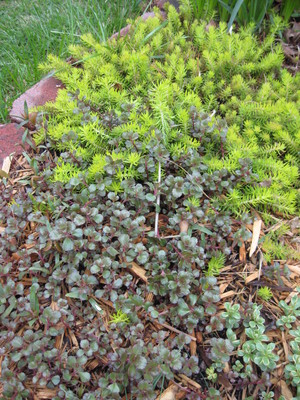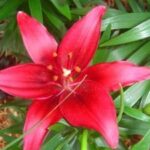Purple foliage is not just pure purple. The leaves of your plants can be tinted with shades of red, bronze, or copper colors. Some leaves can be so dark that they look almost black. Whatever shades of purple foliage plants you choose to incorporate into your landscape, they will be sure to be quite noticeable. Purple can dominate and even overwhelm any area in which it is planted, which is why you should use restraint when using plants with purple foliage.
Shades of purple can be used to tone down masses of hot colors, such as plants with blooms in yellows, oranges, and reds. You can use dark purples with light yellows and light purples with dark yellows and golds. For a really stunning contrast, use really dark purple foliage with white. For example, you might plant an artemisia – ‘Powis Castle’ is my personal favorite – with its lacy silvery foliage. It will really stand out when planted with a purple-leaved canna (Canna indica ‘Purpurea’). The canna’s dark purple leaves offer not only a color contrast but also a textural contrast with its large bold leaves balancing the delicate foliage of the artemisia. You can also try mixing a large bold castor oil plant (Ricinus communis ‘Gibsonii’) with lighter colored ornamental grasses. The grasses swaying in a gentle breeze also offer a textural contrast to the castor oil plant. Of course, you can mix your grasses. I chose a large zebra grass (Miscantus sinensis ‘Zebrinus’) and teamed it with New Zealand flax (Phormium sp.) ‘Anna Red,’ which has some of the darkest purple-red strap-leaves of the flaxes. Another very good contrast is to a smoke tree (Catinus coggygria) with deep purple (almost black) foliage planted with a white variegated dogwood (Cornus alba ‘Elegantissiam). You will find the contrast quite stunning.
Shaded areas, interestingly enough, can benefit from a splash of dark purple. Your collection of hostas will really stand out when they are planted under the canopy offered by a Japanese maple (Acer plamatum ‘Atropurpureum’). You might also wish to add a daphne x burkwoodii ‘Somerset’ that has soft pink flowers. For the border, you might consider adding a ‘Purple Emperor’ sedum that has deep purple foliage (again, almost black) with reddish-purple blooms. I also planted a ‘Black Lace’ elderberry that in my Southern garden prefers shade. It is surrounded by delicate wild violets. (As it grows larger, I will probably be planting different lighter-foliage plants to better show off the elderberry.) The pink blooms of the elderberry really stand out, too, and give the shaded area in which I have it planted a focal point.
Borders can be made more interesting by mixing dark purple foliage plants with your lighter greens. I have, for example, a ‘Purple Amethyst’ heuchera (coral bells) planted with some creeping Jenny. The heuchera really stands out above the bright yellow of the golden creeping Jenny (Lysimachia nummularia ‘Aurea’). I have also mixed ‘Dragon’s Blood’ sedum with ‘Angelina’ sedum. The ‘Dragon’s Blood’ usually starts out a deep green and turns to a purplish-maroon as fall approaches; however, mine seems to become darker much earlier in the year. It is interesting to have small swaths of the darker sedum winding like a path through the bright green of the ‘Angelina.’
These are just a few examples of how you can incorporate purple into your landscape. As long as you remember not to overload your garden with too much purple foliage, you will find that the various shades of this regal color will had depth and interest to your landscape.
Reference:
Gilseenan, Fiona, ed. Color Round the Year. Pleasantville, NY: The Reader’s Digest Association, Inc., 1994, pp. 39-42.
See also: Creating a Garden with Yellow Foliage







